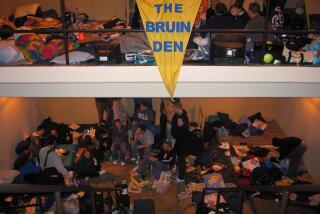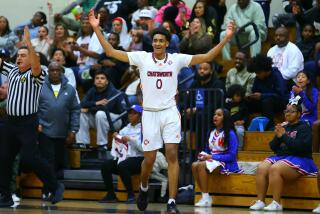THE TALES OF TWO PLAYERS : Garnes Follows a Dream to SDSU
SAN DIEGO — Kieishsha Garnes will never forget that day in May 1987.
It was a Wednesday. And it was raining.
It was the day Nettie McCaskill died. Gone was the grandmother who was Garnes’ parent, friend and confidante. Gone was the stability for which only abiding love has the patience. Gone was someone who cared.
But still alive were a teen-ager’s dreams, and still solid was the foundation Nettie McCaskill laid. Kieishsha Garnes would go to college. She would play big-time basketball. She would persevere.
“(McCaskill) always told me to keep up the hard work and just keep trying--don’t let your opponent beat you out,” Garnes said. “Just keep working hard and don’t get down on yourself.”
That is how Garnes matriculated from Brooklyn, N.Y., to Hilbert College, a two-year school in Hamburg, N.Y., to San Diego State, where, as a 6-foot-3 center, she ranks 24th nationally among Division I scorers, averaging 21.6 points a game, and 28th in rebounding, averaging 10.6.
How long ago that day in Brooklyn seems. Garnes, a junior, was sitting in a classroom at James Madison High School when a feeling came over her.
“Something was telling me something was wrong,” Garnes said. “ ‘Kieishsha go home, go home, something’s wrong.’ I was feeling weird, so I went home.”
Garnes’ mother, Rosalyn, met her at the house and told her that McCaskill had a stroke and died.
“I couldn’t believe it; I was just surprised. I went upstairs and everything was changed around and the house was different,” Garnes said.
Soon, life for Garnes and her older sister, Andretta, became radically different, not that the children weren’t already braced for change.
Kieishsha was 9 before her mother began living with them.
“Until she showed up, I never knew who she was,” Garnes said. “She was in the house and I was asking my sister, I said, ‘Who’s that lady?’ and she said ‘That’s our mother.’ I said, ‘Our mother?’ “She just began living with us. She stayed with us until my grandmother passed away. Then me and my sister had to leave. I began staying with friends, my uncle, with cousins. Then I went off to school.”
Attending a junior college was not what Garnes had in mind. She said it took some convincing from her high school coach, Neil Greenfield, and her uncle, Raymond Jackson.
“They gave me advice to go to a (junior college) to get my grades up and prepare me for a four-year school after what happened,” she said. “They said it would give me a peace of mind, because if I was going straight out of high school after my grandmother passed away into a four-year school, it would have been kind of hard.”
At Hilbert, Garnes scored 1,168 points and averaged 18.2 points and 10.5 rebounds a game, leading the school to the national junior college tournament both years.
Basketball recruiters who sought her when she was in high school kept track of her at Hilbert. And in 1989, Garnes gained more national exposure as a member of the Olympic Festival East team.
“It was a lot of pressure,” Garnes said of the recruiting. “I had letters stacked up from wall to wall.”
Among the suitors were Tennessee, Arizona and Long Beach State. Finally, Garnes decided on San Diego State, becoming part of a recruiting class considered to be the best the school has assembled.
It is a special group for second-year SDSU Coach Beth Burns because it is her first recruiting class as a head coach. In fact, Burns earned her reputation as a recruiter two years ago as an assistant at North Carolina State, where she put together one of the top classes in the nation.
“When you’re an assistant, recruiting is hard because you get closer to kids and theymight say, ‘I’m only going to come here if you’re going to be here for all four years,’ ” Burns said. “As an assistant coach, you can’t say that. With these women, we went in and visited, I knew they were mine. We have a dream that we want to accomplish at San Diego State, and they are going to be the first step. They are the ones that are the believers. For now until forever, this will be the most special class.”
Burns’ assistant coach, Yvette Angel, who is from Buffalo, heard about Garnes through Hilbert Coach Sal Buscaglia.
“Recruiting is a challenge,” Burns said. “Kieishsha was very high-profile. (She) had been an All-American the year before. (She) was being sought after by everyone in the nation. And I think that just motivates us harder.”
The Aztecs are 9-8, 2-2 in the Western Athletic Conference, and Garnes is third in the league in scoring with a 21.6 average. She leads the conference in rebounding with a 10.6 average and is among the top 10 in shooting percentage, free-throw percentage and blocked shots.
Burns said Garnes is adjusting well to Division I competition but said she thinks Garnes might become frustrated since she came from a dominant junior college program and was used to winning all the time.
“She’s double-teamed, triple-teamed and even quadruple-teamed,” Burns said. “At Texas Tech (when she had 30 points and nine rebounds), she was tremendous. . . . She did the same thing the night before at Santa Barbara. Only in the case of Texas Tech, we lost.
“She couldn’t have done anything more. She couldn’t have done anything more but shut the lights off and mop the floor when we left. And we still lost. I think that’s frustrating for her. She’s so dominant that usually her domination alone can carry a team to a victory.”
Garnes was attracted to SDSU because of the promise the program showed under Burns. It was easy to leave Brooklyn, but . . .
“I always wanted to go far away,” Garnes said. “But then when I got here, I wanted to go home because I had problems. But I just said ‘Hey, get through it, you only got two years here.’ It’s getting better. I’m getting adjusted.
“I miss home, but in a way I don’t. I really don’t have anything to go back home to but a few people I keep in contact with.”
Her sister Andretta, now 22, still lives in Brooklyn and has a 2-year-old daughter, Jessica.
Two weeks before coming to San Diego, Garnes saw her father, Darrell, whom she hadn’t seen since she was 11.
“It’s kind of weird,” she said. “I always said, ‘I want to see my father.’ When I saw him, I just felt that love in my heart. I wanted to tell him I love him but I just couldn’t. He has some of my trophies that he took with him.”
But Garnes has a new family now, having become close to her roommate and teammate, Tameka McGlawn, a freshman forward from Arlington, Va.
“Both of us moved out here on our own,” McGlawn said. “We started from scratch buying household stuff . . . We have a new little family. I consider her like my big sister, my family.”
Both are intense players, in practice and in games, but McGlawn said they try not to take it back to their apartment with them, although sometimes it happens.
“They kill each other in practice,” Burns said. “They’re both very intense and work very hard. Both are winners as people and players and they want to be good.”
It was a big step for Garnes to go from the success of junior college to the uncertainty of playing at the Division I level. And it was even a bigger challenge now that McCaskill wasn’t there with her advice and understanding.
“I always wondered, ‘Will I do well, or will I be afraid to take that step?’ ” Garnes said. “I just took the step. I just had the confidence. I knew I’d do good. I know I’m not a failure. I always push myself and rise to another level.
“If I see myself falling, I just pick myself back up. I have that support around me to help me. Sometimes I feel I don’t have that support, because I always felt that support from my grandmother.
“But now I know there’s people around me who care.”


